In what turned out to be yet another tumultuous season for Club Brugge, the 18-time Belgian champions sacked Ronny Deila in the middle of March, after less than a year in charge and even though he guided the club to the title playoffs and the quarter-finals of the Conference League.
The club then turned to Nicky Hayen as his temporary replacement, with the current Club Nxt head coach promoted to the first-team role until the end of the season.
However, the 43-year-old may have given himself a legitimate shot at getting the job permanently, with Hayen unbeaten in his eight matches in charge so far.
He has them level on points at the top of the table with Anderlecht domestically while also guiding them past Greek giants PAOK in the Conference League quarter-finals to set up a European semi-final with Serie A side Fiorentina, something a Belgian club has not achieved since 1993.
This tactical analysis will
examine Nicky Hayen’s tactics in-depth and discusshow Club Brugge has managed to have such a dramatic upturn in form under the 43-year-old Belgian.
The Belgian side has a chance to win two trophies still this season.
Nicky Hayen Preferred Formation
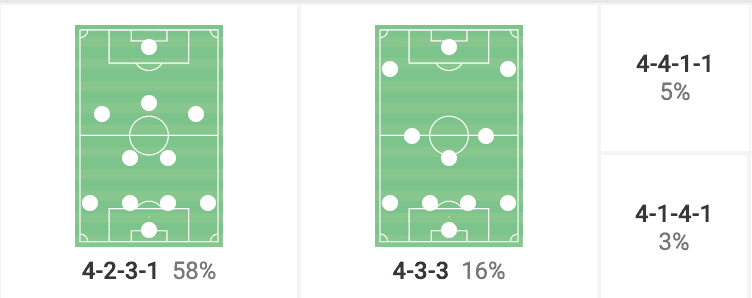
As mentioned at the beginning of this tactical analysis, Nicky Hayen has only been in charge of the senior side for eight matches, so the graphic above gives a more detailed look at what Club Brugge have played all season.
However, since Hayen’s appointment, he has not really looked to change much from a formation perspective, with the Belgian sticking with a back four.
More specifically, Nicky Hayen’s preferred formation has usually involved setting Club Brugge up in either a 4-3-3 or 4-2-3-1 formation, which tends to look more like a 4-1-4-1 when Club Brugge is out of possession and in the defensive phase.
But more on that later in this analysis.
Nicky Hayen In-possession principles
First, we will take a more detailed look at Hayen’s tactics when his side is in possession with the goalkeeper and the overall in-possession principles that are beginning to evolve under the 43-year-old Belgian’s leadership.
Club Brugge Pass Map
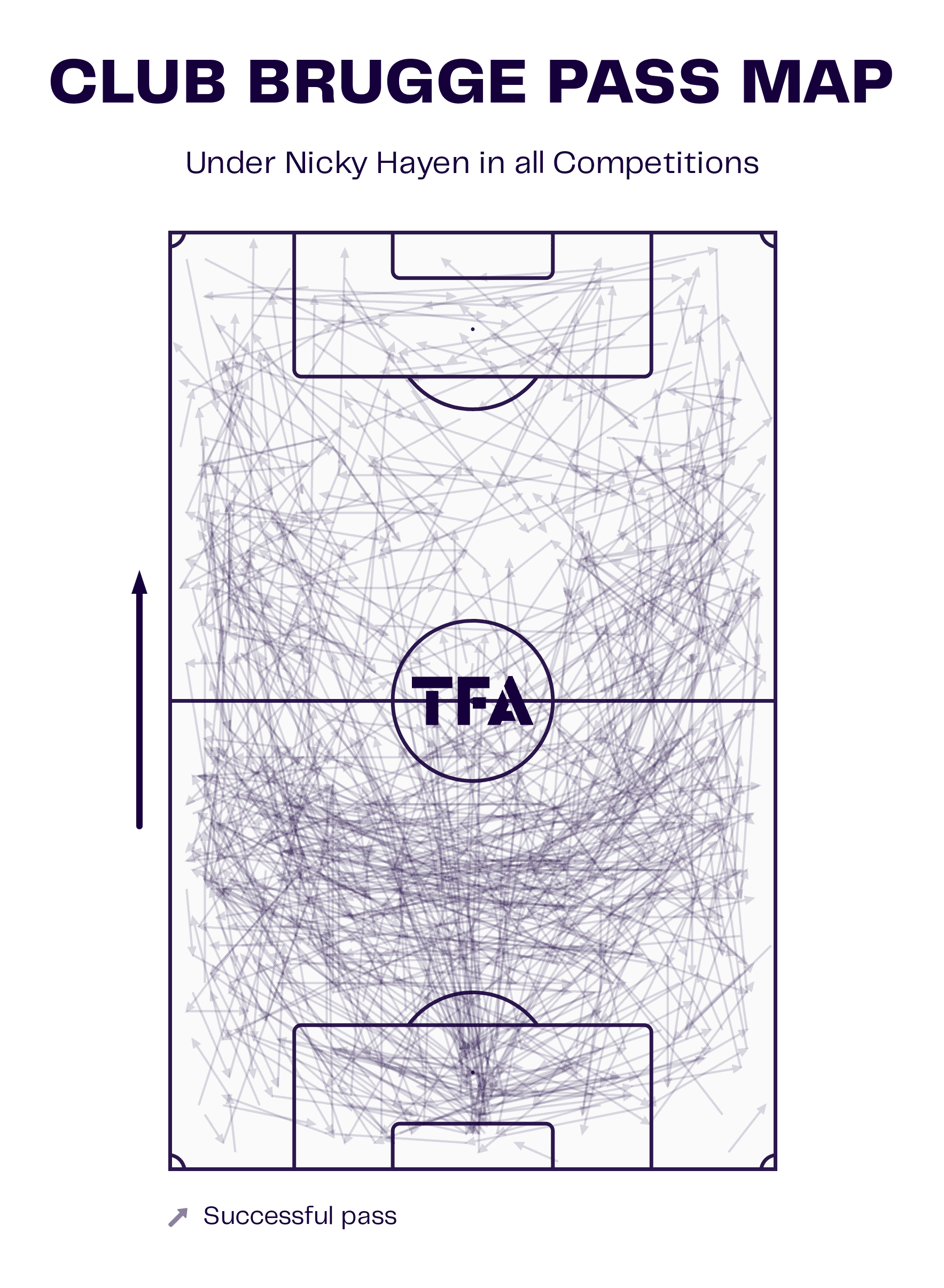
The data viz graphic above shows Club Brugge’s pass map during Hayen’s matches in charge, and this allows us to get more insight into how the Belgian side has looked to play in possession under the 43-year-old.
As we can see, Club Brugge tends to play more side-to-side and horizontally and be more possession-focused in the defensive third of the pitch.
Nigerian midfielder Raphael Onyedika has a pivotal role under Hayen in possession inside the defensive third.
As the ball reaches the middle and attacking third of Hayen’s side, they shift away from a more possession-oriented approach and look to play more direct and vertical.
It is also common for the ball to be played long directly from the goalkeeper during phases of build-up play.
They also look to frequently overload the wide areas.
The wingers tend to stay very wide when Club Brugge is in possession, and the full-backs look to get advanced as well.
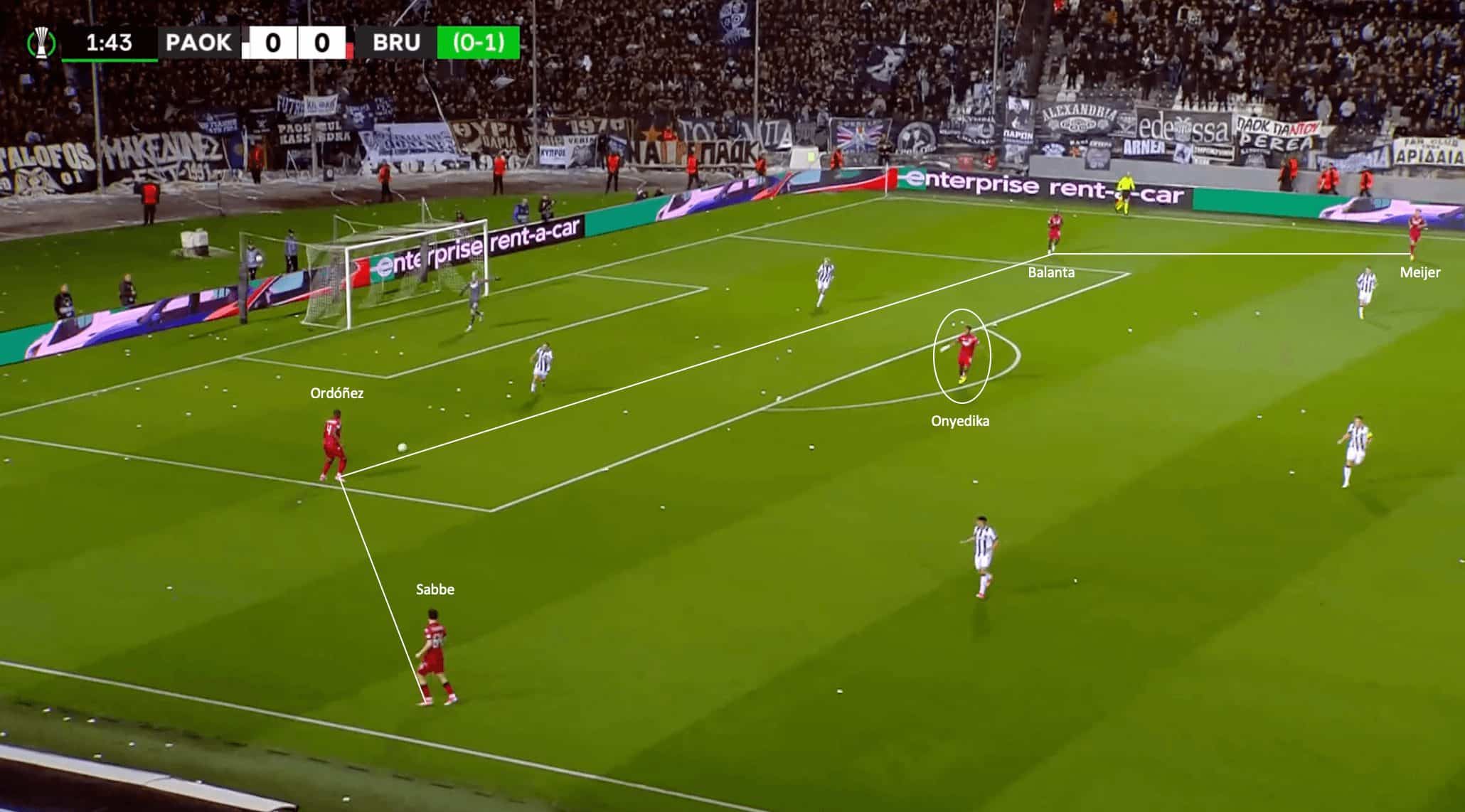
The image above shows an example of this in the possession phase, starting from the goalkeeper in Club Brugge’s recent European quarter-final second leg against PAOK.
The first thing that stands out is how stretched the defence is, with both centre-backs operating essentially outside of the 18-yard box and the full-backs keeping a shorter distance but staying wide against the touchline.
It is also crucial to notice Onyedika’s positioning.
The Nigerian international plays a more free-roaming role at the base of the midfield three and looks to support the back four.
The midfielder always tends to end up in possession at some point during these phases, with it usually resulting in bounce passes to get out the other way or to drag the opposition shape out to open up pockets for the advanced midfielders to drop into and receive either second balls headed down by the central striker, or to receive floated passes in the pockets for them to turn and drive, with this shape and movement off the ball able to create overloads as well.
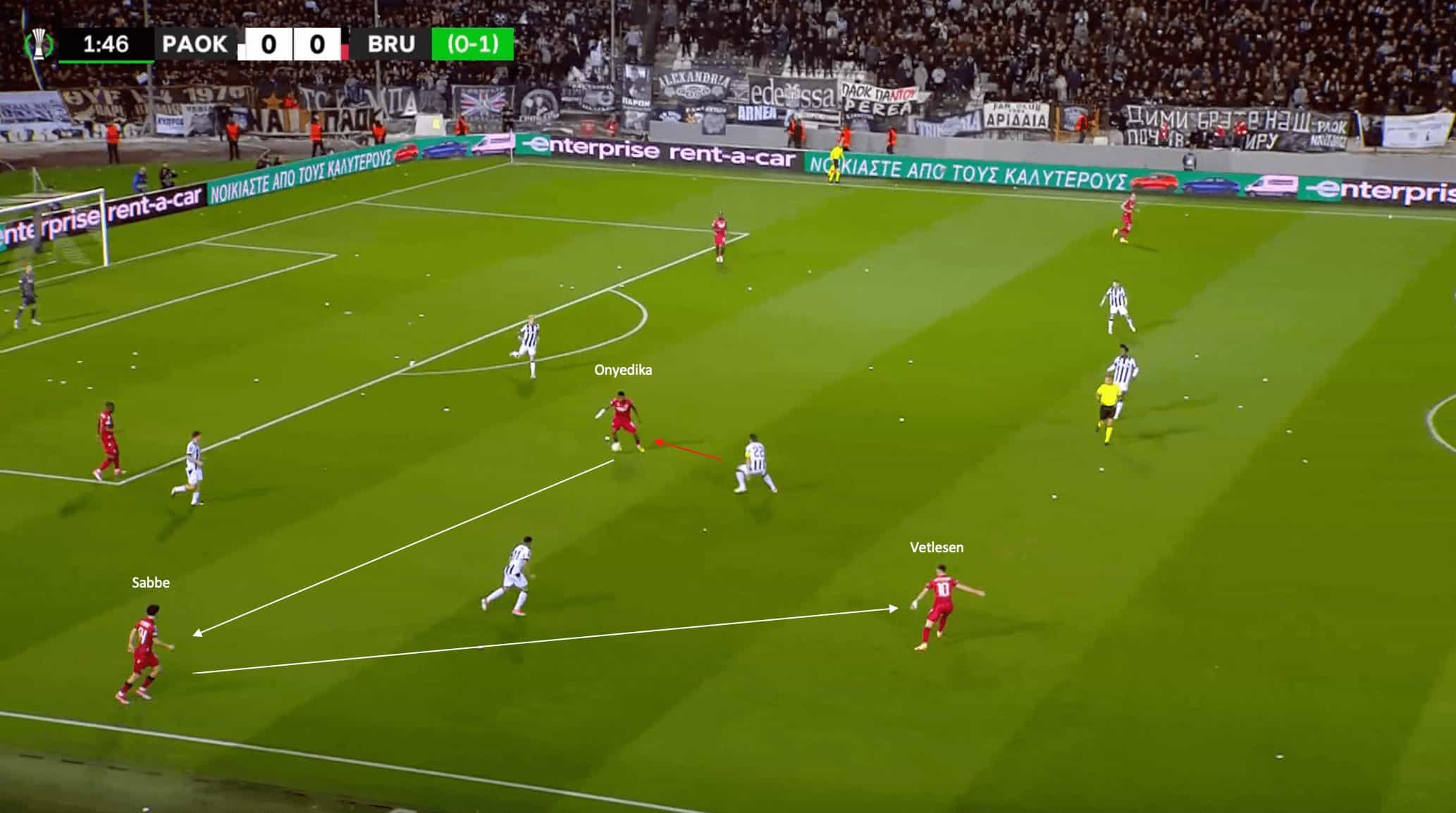
The figure above shows what happens as the in-possession phase progresses for Club Brugge.
As we can see, the Belgian side has managed to create an overload against PAOK, with Hayen’s side creating a 3v2 numerical advantage.
As Onyedika receives the ball from centre-back Joel Ordóñez, the Nigerian international gets put under pressure by the opposition midfielder, freeing up Hugo Vetlesen, as this player was marking the Norwegian midfielder.
This is for PAOK‘s wide midfielder to drop off and close the passing lane directly to Vetlesen, leaving Kyriani Sabbe unmarked.
Onyedika quickly gets the ball out from under his feet, finding the young full-back on the touchline before he can play a two-touch pass to Vetlesen down the line and release him into space.
When they are not looking to create overloads in the defensive and middle third, another strategy employed by Nicky Hayen during phases of build-up play is looking to play more direct as opposed to using positional play and passing sequences to progress the ball into the attacking half.
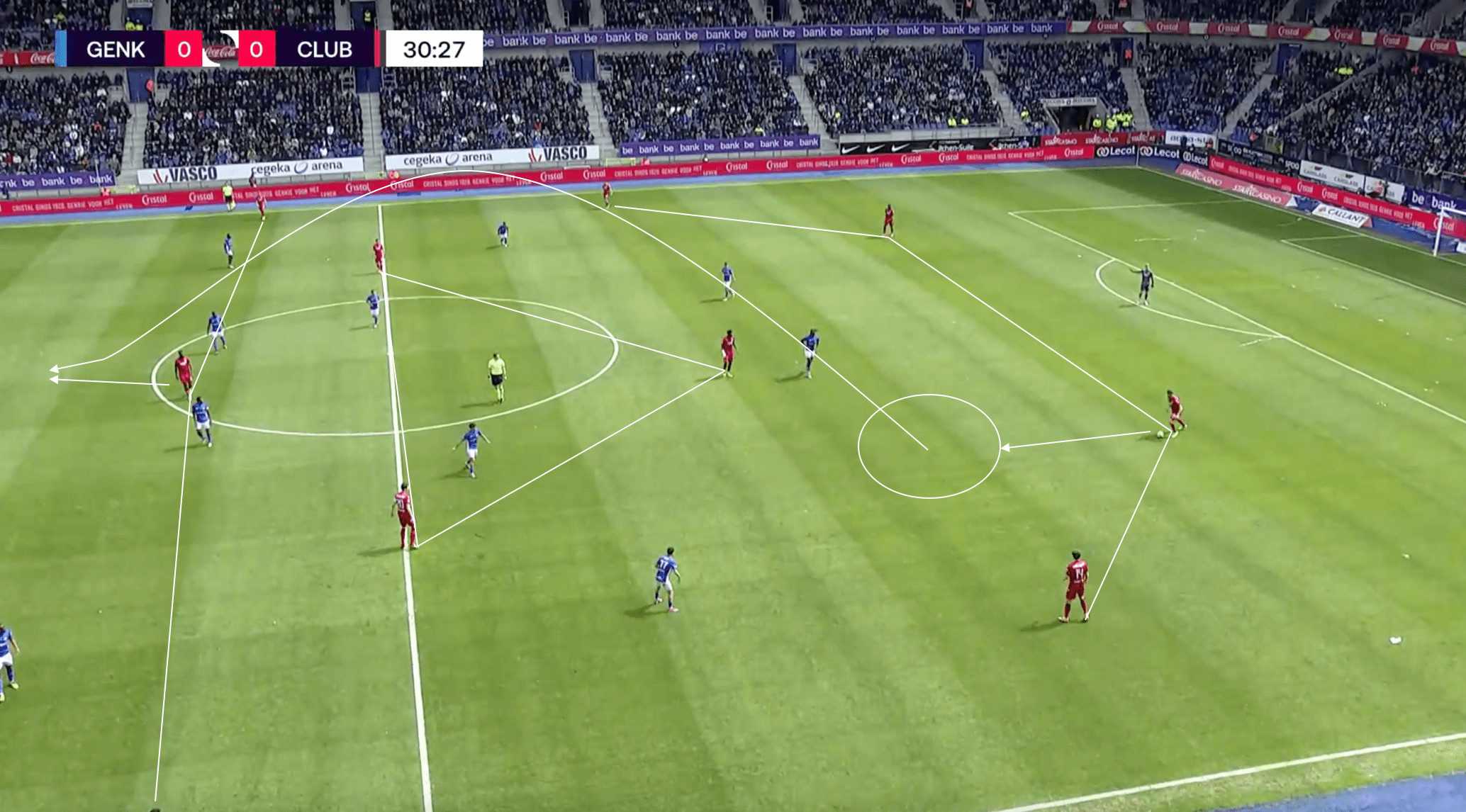
In this image, we can see how wide Club Brugge can become when they are in possession of their defence.
The back four hold really wide positions, with the midfield three also looking to stretch the field and create pockets of space in the midfield.
In the attacking half, the front three are almost set up in a straight line, looking to stretch the Genk defence.
Defensively, Genk did really well. They sat off and did not push their midfielders high to press, instead looking to hold the numerical advantage in the midfield, essentially being 6v3 against Onyedika, Hans Vanaken, and Vetlesen.
With the option of playing between the lines off the cards, centre-back Brandon Mechele instead looks to go route one, play direct.
He is allowed the space to drive forward a few steps before spotting the run of Brazilian striker Igor Thiago on the shoulder of the last defender.
His long ball finds the head of Thiago.
After some loose ball duels in the midfield, Club Brugge escapes out the far side and reaches the Genk penalty area, creating a goalscoring chance.
Under Nicky Hayen’s style of play, Club Brugge has been able to form multiple identities when in possession in the defensive and middle third, which has greatly benefited their ball progression in recent weeks.
Chance creation in the final third
Regarding chance creation and goalscoring, Club Brugge has been free-scoring when reaching the final third under Nicky Hayen’s tactics, with 19 goals scored in his eight matches in charge — that’s over two goals a game on average.
Club Brugge Progressive Passes Map
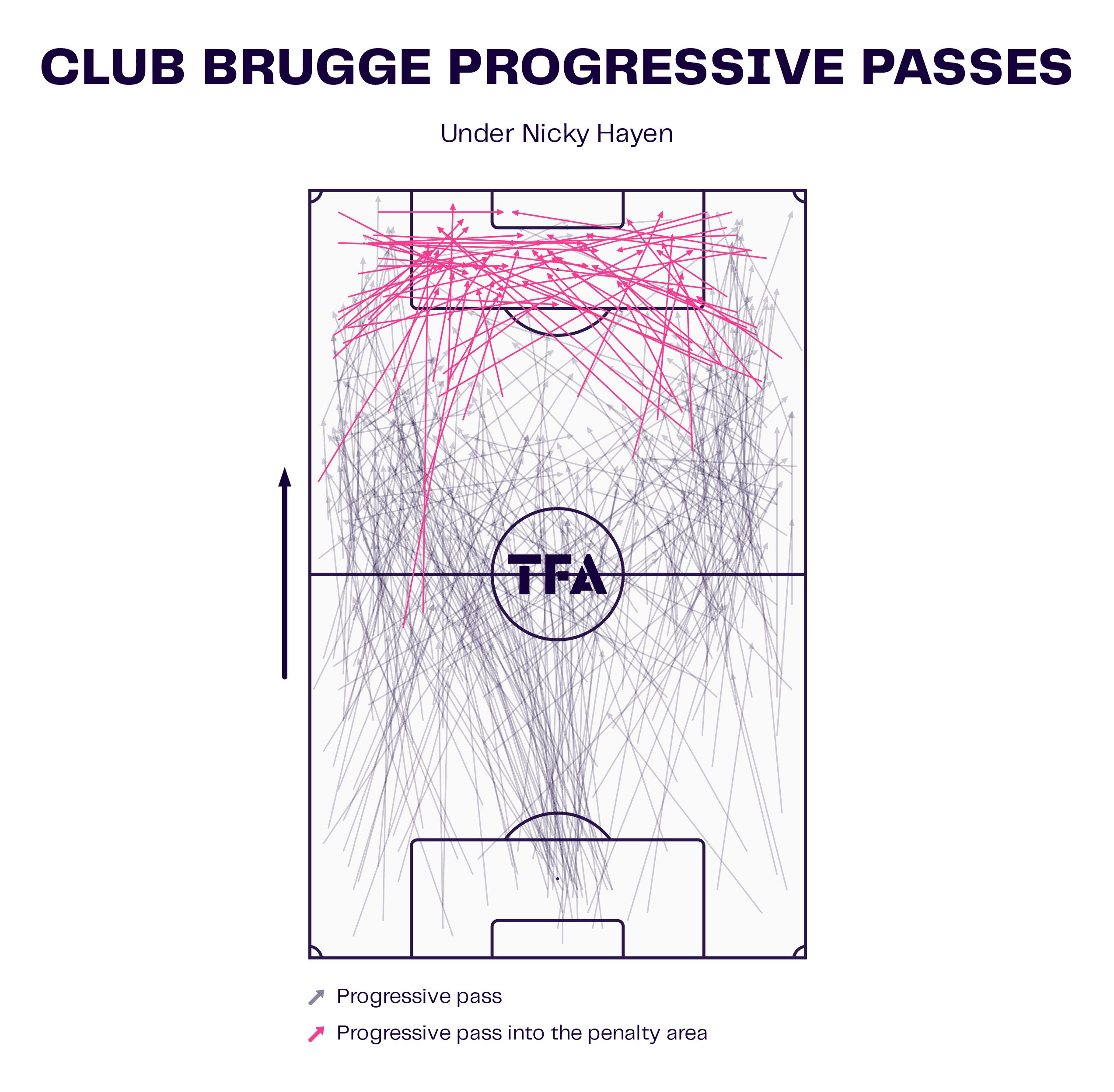
The data visualization graphic above gives us a more detailed look at Club Brugge’s chance creation under Hayen and where they have tended to create these chances.
As we can see from the progressive passes under Hayen, focusing more on the final third area, most of these passes into the penalty area come from the wide areas, with the ball progressing into the wide channels as the Belgian side advances the ball forward.
We already discussed how Club Brugge will try to create overloads in the defensive half of the pitch when they are in possession of these areas.
Still, they will also look for these opportunities in the final third, with the wingers and full-backs having a huge impact in chance creation Hayen’s appointment.
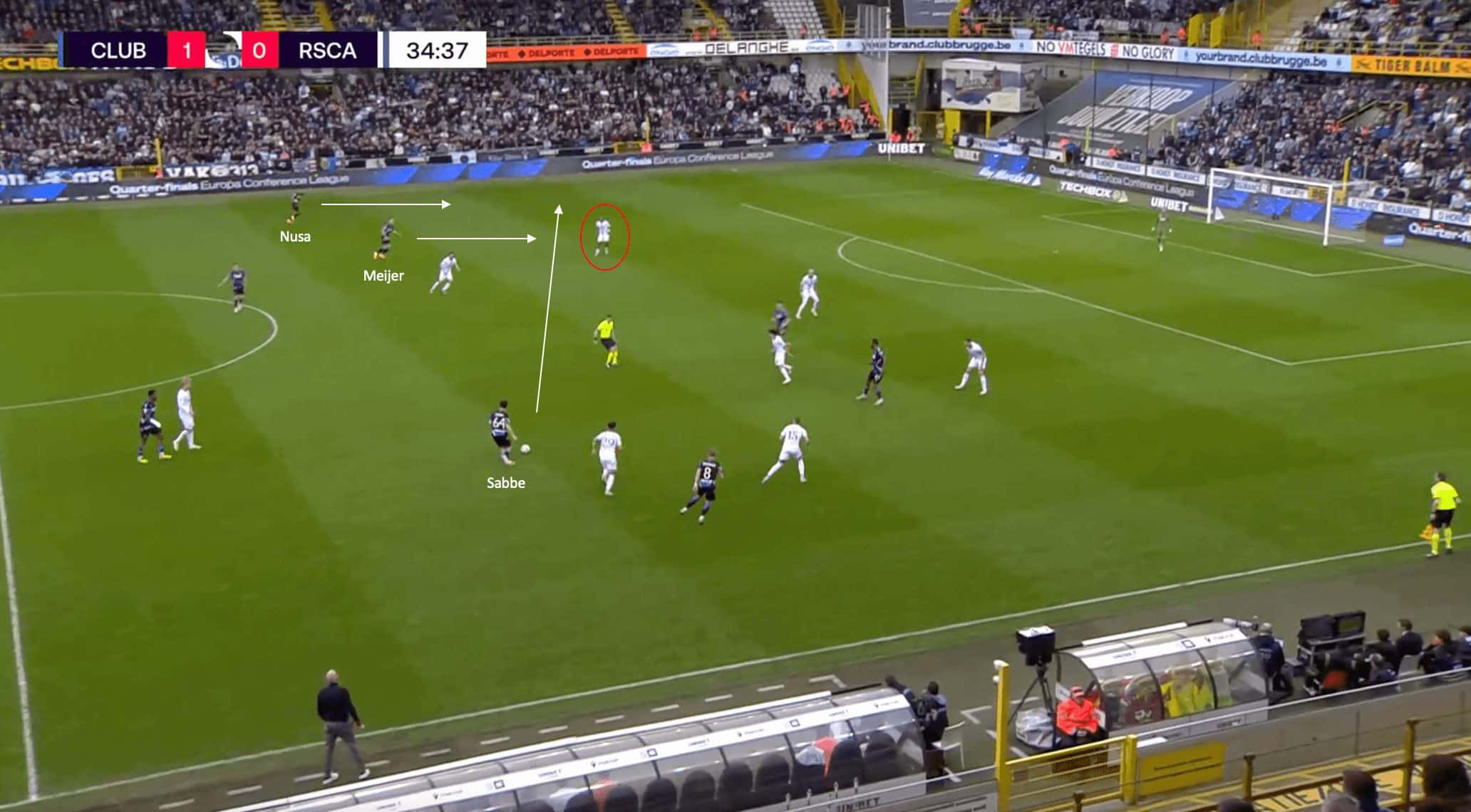
The image above shows an excellent example of how Club Brugge has approached attacking in the final third under Nicky Hayen.
In this phase of play above against Anderlecht, right-back Sabbe is currently in possession of the ball.
The 19-year-old Belgian is holding a more inverted position, allowing right winger Michał Skóraś to stay in a wider position.
On the far side, the same can be said.
Left back Bjorn Meijer gets advanced, also into a more inverted position, and left winger Antonio Nusa is allowed to stay wide.
Under Nicky Hayen’s managership, Club Brugge has not looked to attack down one flank.
They constantly look for the switch of play in the middle third if it presents an opening.
This is what happens here, with Meijer and Nusa able to create an overload and isolate the full-back 2v1, with it also arguable that they have created a 3v2, as striker Ferran Jútgla has dropped into a deeper position on the far half of the pitch, with this resulting from Club Brugge looking to shift numbers towards the ball to attract more players from the opposition over, congesting the zone, while also usually resulting in a free switch to the opposite side.
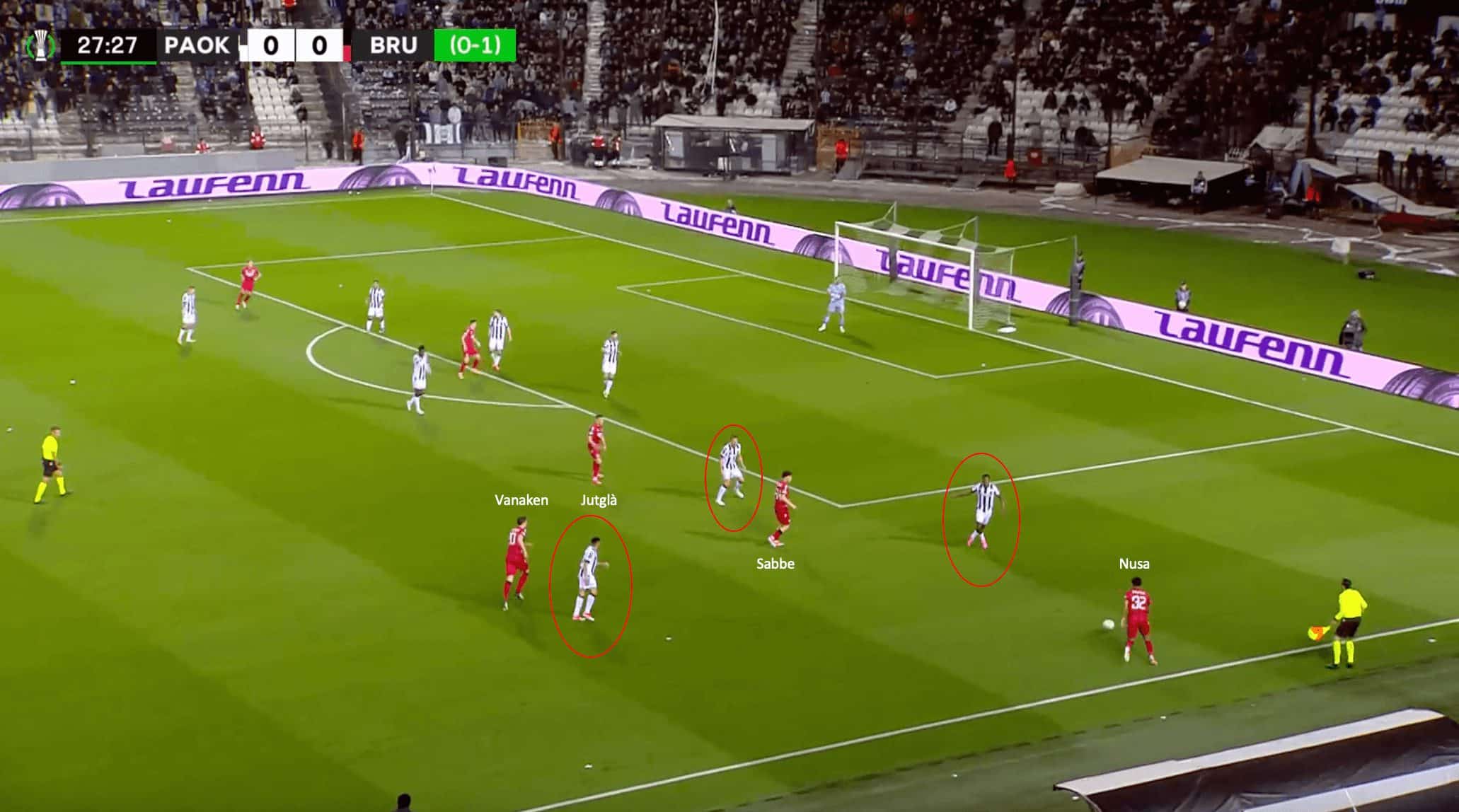
The image above shows the first part of an attacking phase from Club Brugge.
As we can see, the Belgian side have managed to create an overload against the PAOK defence.
The first thing to notice is the continuing trend of the full-backs getting advanced and inverting.
At the same time, the wide attackers will play as more traditional wingers and stay wide, looking to isolate themselves 1v1 against the opposing full-backs and create a 2v1 against the defender with the inverted full-back.
Captain Hans Vanaken has also managed to drift into this half-space, and striker Jutglà has also shifted to this nearside to complete the overload.
This type of attacking tactic means Club Brugge will always have a free player, as we can see in the following image as the phase of play progresses into the penalty area.
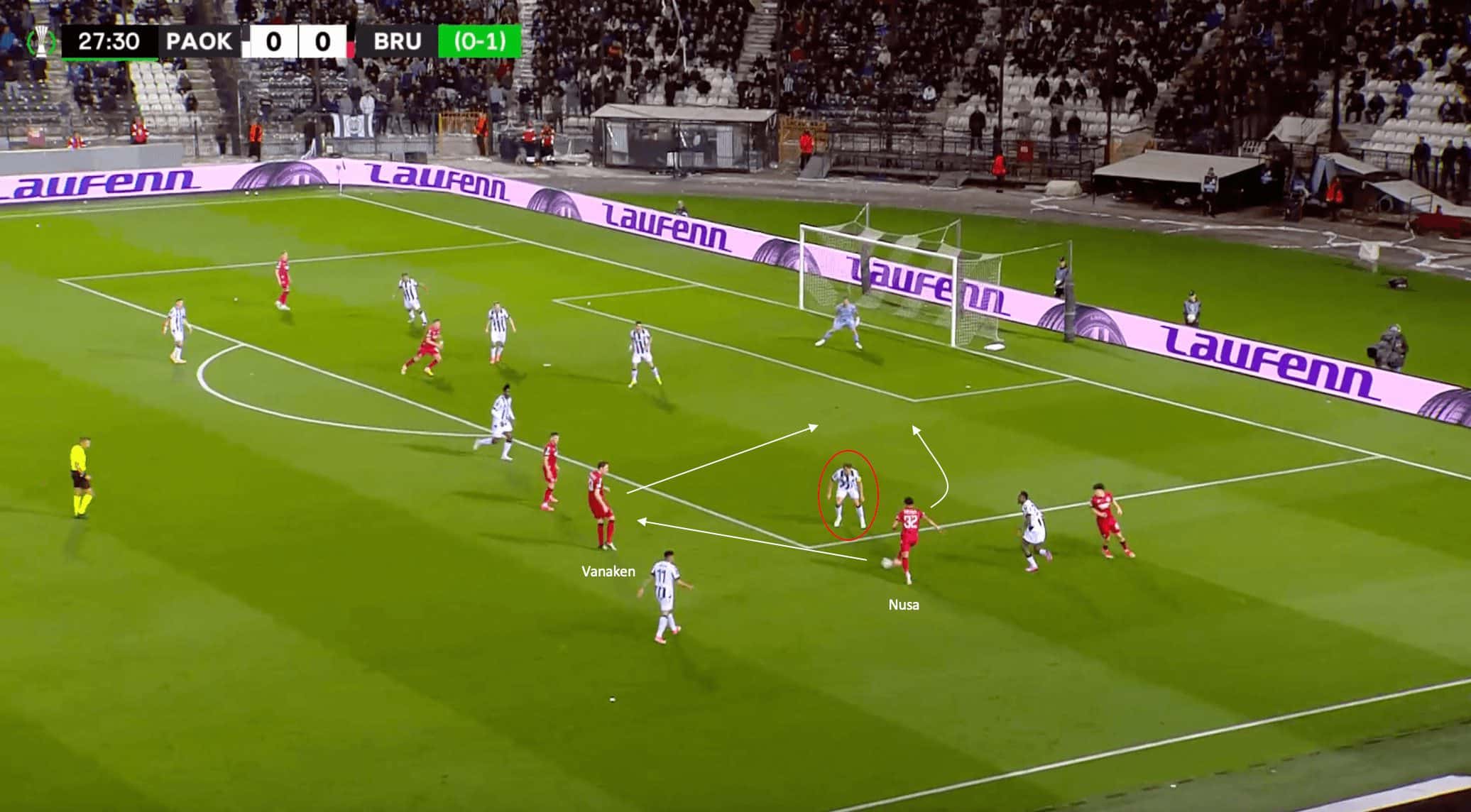
The figure above shows what happens as the attacking move progresses for Club Brugge.
As mentioned in the previous example, Nicky Hayen’s strategy in the final third to get numbers around the ball and create overloads usually means there will always be at least one free player if the defence does not shift to compensate.
As Nusa drives inside, he gets past the PAOK full-back with relative ease, which opens the gap for Nusa to drive towards the PAOK defensive midfielder who has dropped into defence.
He becomes detached from the rest of the backline as a result of shifting to prevent the young Norwegian international from driving into the penalty area uncontested.
As a result of the overload, Hans Vanaken becomes the free player, with the club captain and Belgian international receiving the ball inside from Nusa.
After passing off possession, the 19-year-old winger continues to drive towards the defensive midfielder, who gets caught ball-watching.
This allows Nusa to drive into the space behind the defence uncontested.
This allows Vanaken to play a first-time pass back into the path of the winger, but his shot gets blocked and goes out of play for a Club Brugge corner.
Nicky Hayen Out-of-possession & defensive principles
Finally, we will take a more detailed look at the out-of-possession and defensive principles that have begun to stand out from Hayen’s time in charge at Club Brugge.
The Belgian side have only conceded three goals in Hayen’s eight matches in charge across all competitions.
This is not to say that Club Brugge defended poorly under Deila, but just that they were put more under pressure due to the lack of goalscoring ability near the end of Norwegian’s time in charge.
Club Brugge Defensive Territory Map
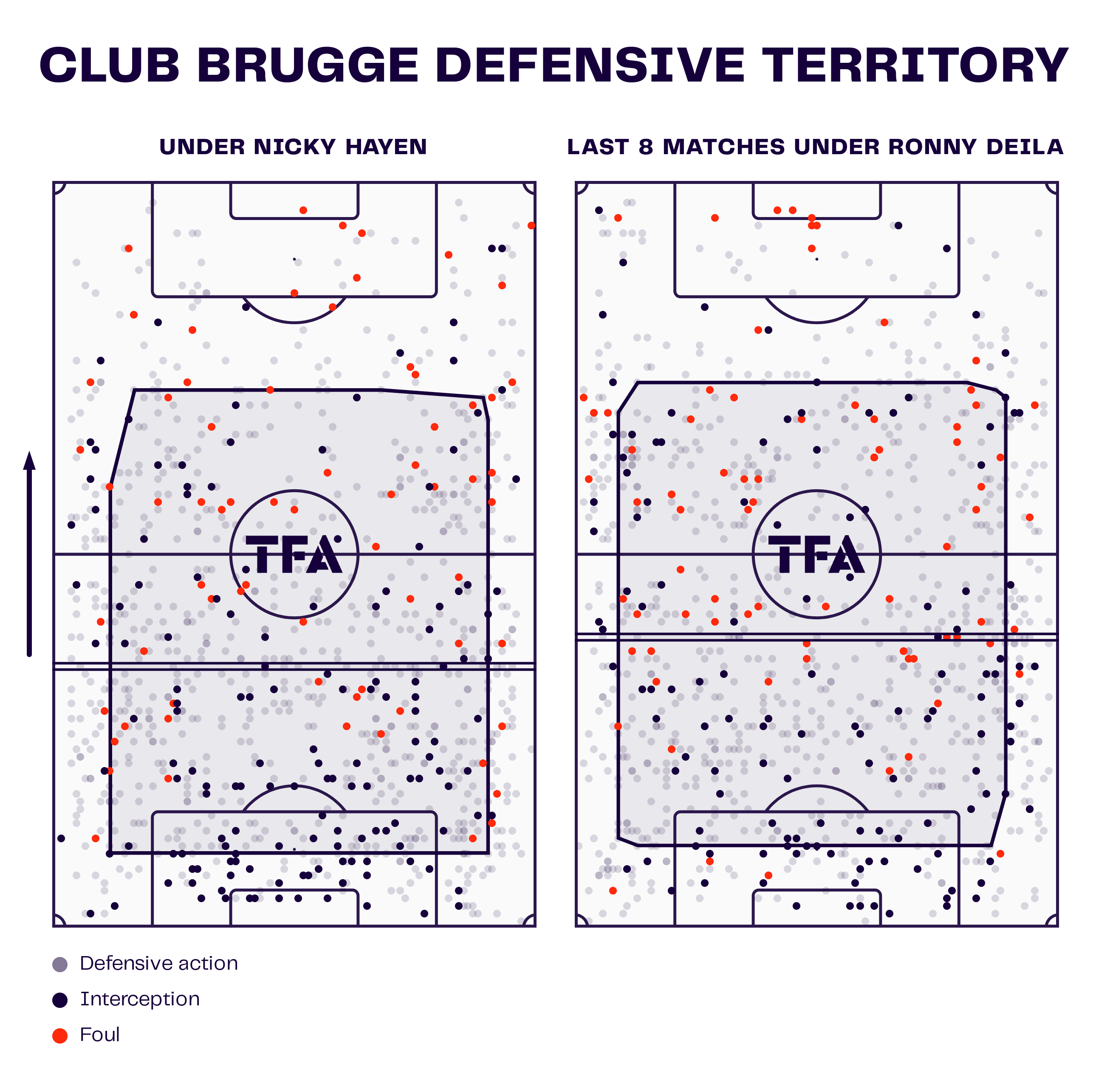
One thing that Hayen has implemented since his appointment is the introduction of a deeper average defensive line.
The left graphic shows Club Brugge’s defensive territory since the 43-year-old’s appointment and the right graphic shows their defensive territory during Deila’s last eight matches in charge.
Club Brugge has not looked nearly as aggressive under Nicky Hayen’s style of play.
They tend to sit back in what looks like a 4-1-4-1 narrow defensive shape, with Raphael Onyedika acting as a single pivot.
Under Hayen’s tactics, they have also committed more defensive actions in the half spaces inside the middle third, with few defensive actions in the centre of the pitch just inside the attacking half.
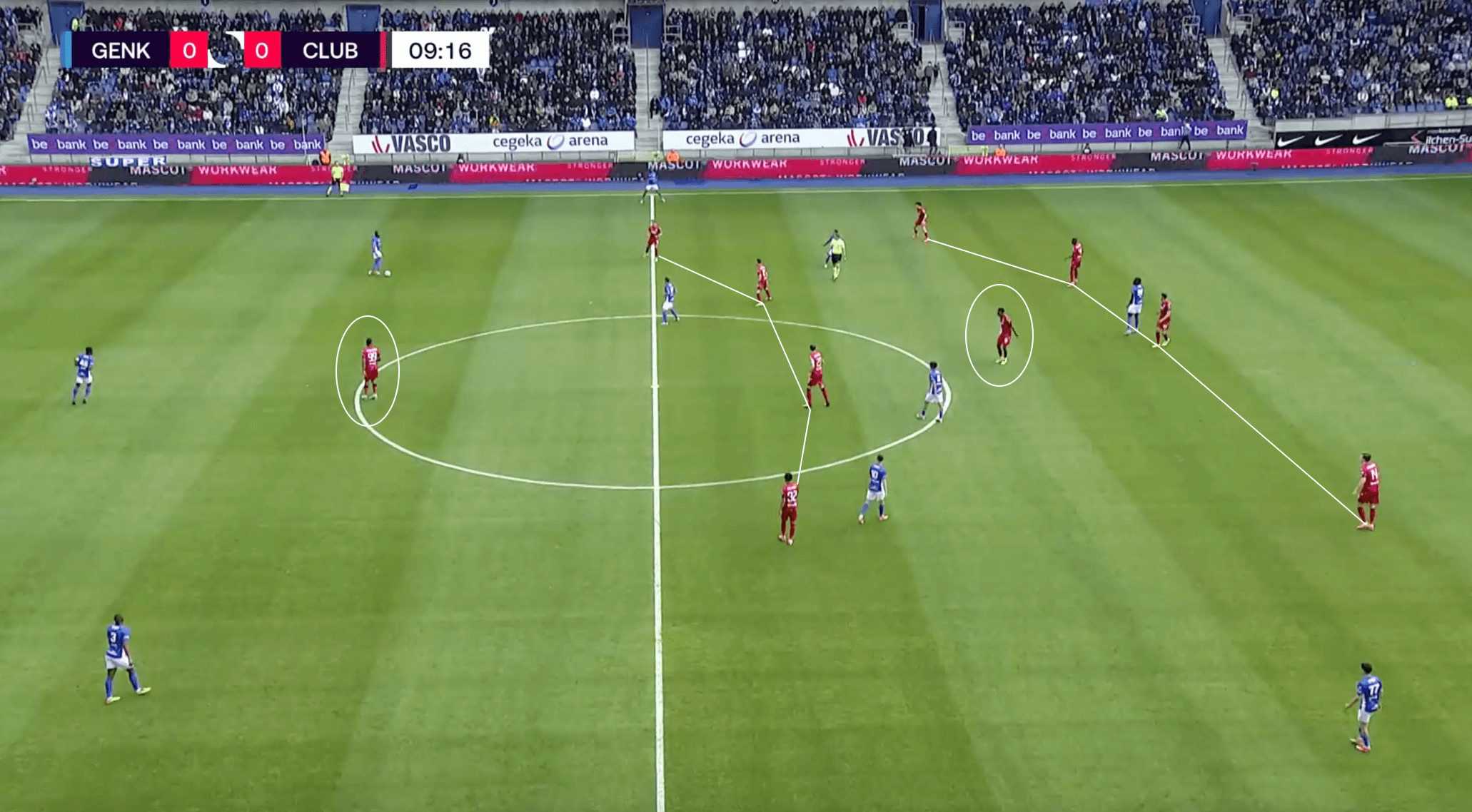
The image above shows an example of the defensive shape Club Brugge has tended to adopt out of possession under Nicky Hayen.
Compared to their in-possession shape, where they look to get really expansive to create plenty of widths, quite the opposite is true defensively.
Hayen has looked for them to be more passive out of possession, which leads to fewer defensive breakdowns with this lack of a high defensive line at all times.
The 4-1-4-1 shape is pretty evident in this defensive phase of play against Genk, with Onyedika acting as the single pivot and striker Igor Thiago staying further forward and positioning himself inside the attacking half.
This narrow and compact defensive shape prevents Genk from playing passes on the ground between the lines.
The only advanced option is the defensive midfielder, who would be put under immediate pressure if he were to receive possession.
Genk‘s only option is to play between their centre-backs and full-backs, which Thiago allows them to do before they are eventually forced to play long.
This works in Club Brugge’s favour, with the defensive line able to gather possession and keep the pressure off them defensively.
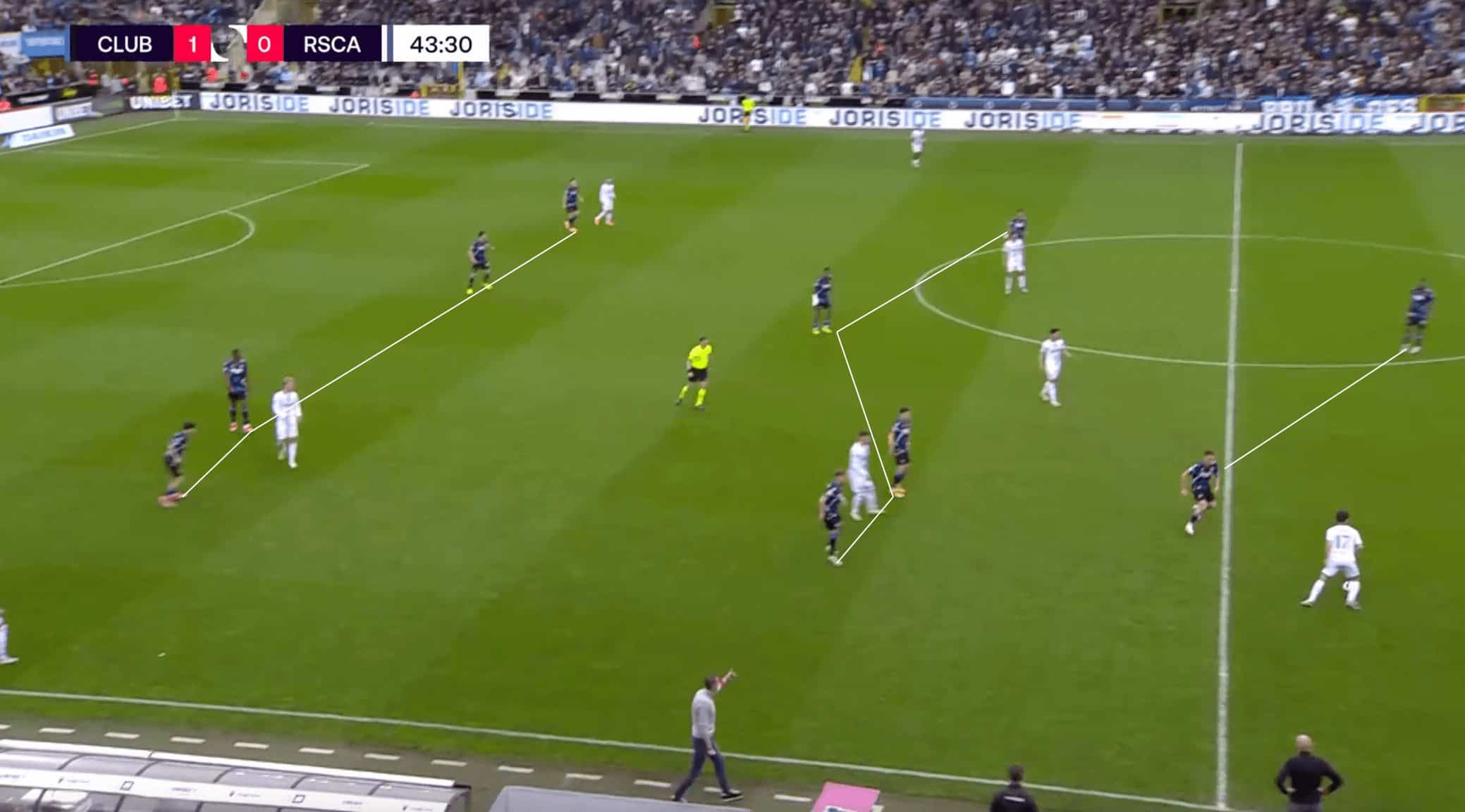
The image above shows another example of the defensive shape that Club Brugge has tried to establish under Nicky Hayen.
While it tends to look like a 4-1-4-1, it can also shift into more of a 4-4-2 mid-block shape, as shown in the image above.
They still look to get compact, narrow off the ball and prevent any ball progression between the lines from Anderlecht.
The small defensive changes that Nicky Hayen has implemented have paid huge dividends so far for Club Brugge. The Belgian club has not conceded many goals or even chances since the 43-year-old took over.
With just a bit more defensive stability and a less high defensive line, Club Brugge has become a more well-rounded side defensively.
Conclusion
As this tactical analysis has illustrated, Nicky Hayen has done plenty from a positive standpoint that should warrant his getting a legitimate shot at the job full-time.
It will be interesting to see what Club Brugge does once the season concludes, but if Hayen can win the Belgian Pro League, Europa Conference League, or both, that could be enough to give him the job full-time.



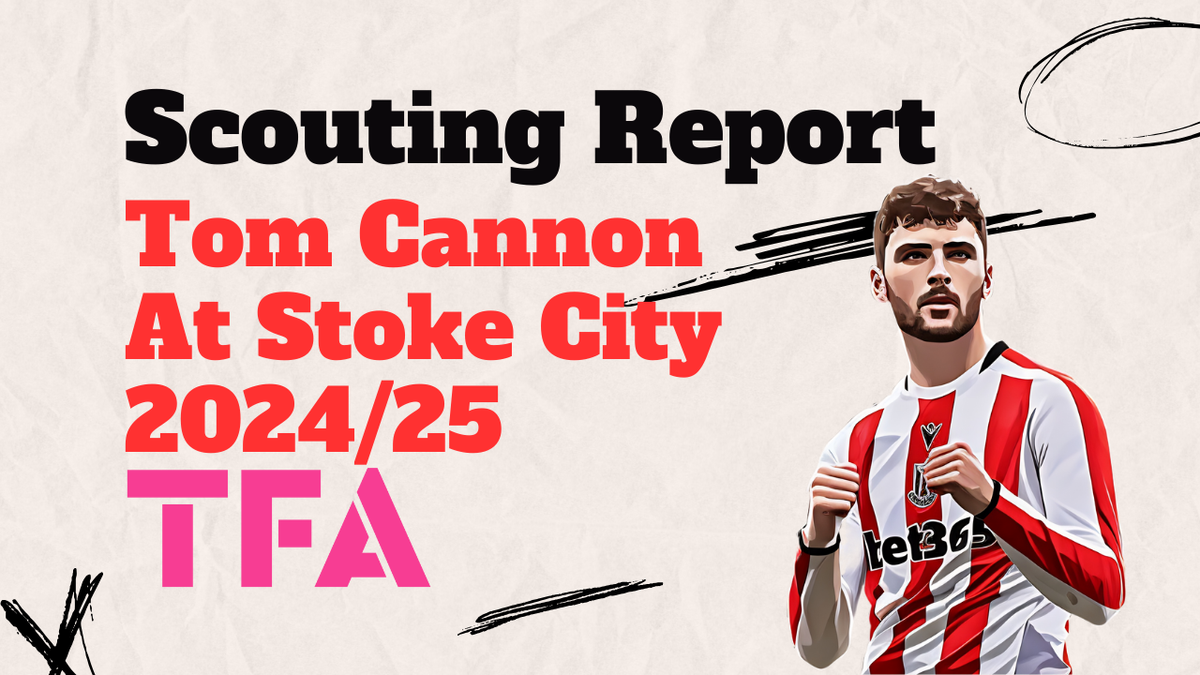
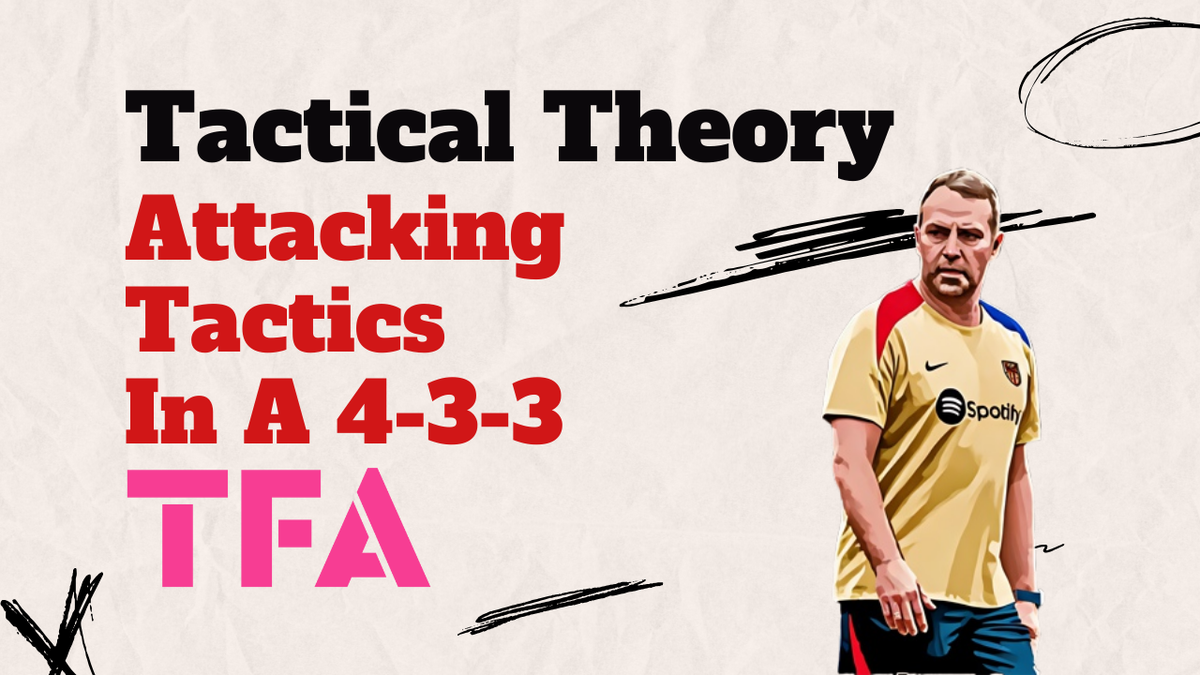
Comments